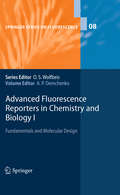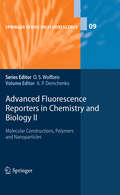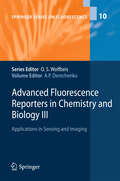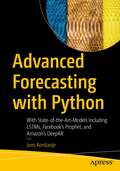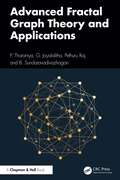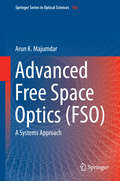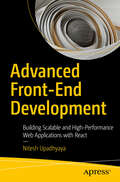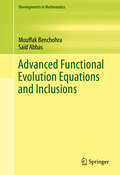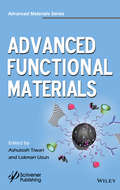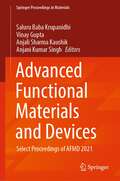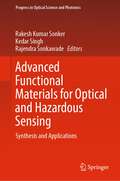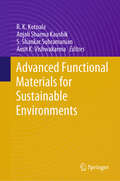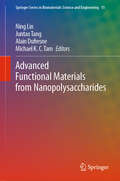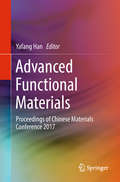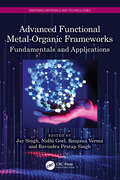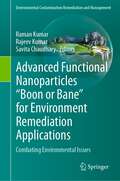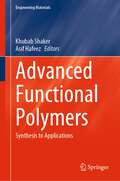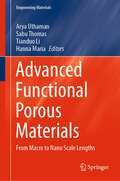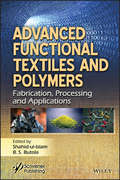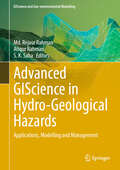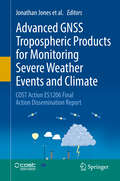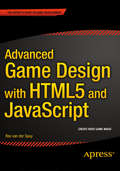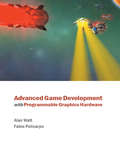- Table View
- List View
Advanced Fluorescence Reporters in Chemistry and Biology I: Fundamentals and Molecular Design (Springer Series on Fluorescence #8)
by Alexander P. DemchenkoThis volume is focused on one of the most important challenges in sensing and imaging technologies: the design of fluorescence reporters with advanced properties. Here organic dyes occupy leading positions, in tough competition with novel materials such as metal chelating complexes and semiconductor nanoparticles. 11 chapters written by top experts in the field show new possibilities in the design of organic dyes as fluorescent labels and reporters. They particularly highlight the progress that has been made in enhancing the response to intermolecular interactions and their excited-state reaction dynamics (intramolecular charge and proton transfers), and on the development of dyes with strong two-photon absorption and emitting in the near-IR region. Furthermore, fluorophores incorporated into new members of the green fluorescent protein family, an invaluable tool for live cell imaging, are examined.
Advanced Fluorescence Reporters in Chemistry and Biology II: Molecular Constructions, Polymers and Nanoparticles (Springer Series on Fluorescence #9)
by Alexander P. DemchenkoThis volume demonstrates the novel possibilities in sensing and imaging offered by the assembly of organic dyes into nanoparticles and nanocomposites and by the application of strongly fluorescent noble metal clusters and conjugated polymers. Its 14 chapters, written by top experts in this field, provide in-depth information on the coupling of organic dyes to different molecular and supramolecular structures, on their incorporation into polymeric nanoparticles and on the nanostructures that can be formed by some of the dyes. Bright and photostable several-atom clusters of gold and silver are examined. Finally, the revolutionary changes in sensing technologies attending the advent of conjugated polmyers and the advances in their application are discussed.
Advanced Fluorescence Reporters in Chemistry and Biology III: Applications in Sensing and Imaging (Springer Series on Fluorescence #10)
by Alexander P. DemchenkoThe key element of any fluorescence sensing or imaging technology is the fluorescence reporter, which transforms the information on molecular interactions and dynamics into measurable signals of fluorescence emission. This book, written by a team of frontline researchers, demonstrates the broad field of applications of fluorescence reporters, starting from nanoscopic properties of materials, such as self-assembled thin films, polymers and ionic liquids, through biological macromolecules and further to living cell, tissue and body imaging. Basic information on obtaining and interpreting experimental data is presented and recent progress in these practically important areas is highlighted. The book is addressed to a broad interdisciplinary audience.
Advanced Forecasting with Python: With State-of-the-Art-Models Including LSTMs, Facebook’s Prophet, and Amazon’s DeepAR
by Joos KorstanjeCover all the machine learning techniques relevant for forecasting problems, ranging from univariate and multivariate time series to supervised learning, to state-of-the-art deep forecasting models such as LSTMs, recurrent neural networks, Facebook’s open-source Prophet model, and Amazon’s DeepAR model. Rather than focus on a specific set of models, this book presents an exhaustive overview of all the techniques relevant to practitioners of forecasting. It begins by explaining the different categories of models that are relevant for forecasting in a high-level language. Next, it covers univariate and multivariate time series models followed by advanced machine learning and deep learning models. It concludes with reflections on model selection such as benchmark scores vs. understandability of models vs. compute time, and automated retraining and updating of models. Each of the models presented in this book is covered in depth, with an intuitive simple explanation of the model, a mathematical transcription of the idea, and Python code that applies the model to an example data set. Reading this book will add a competitive edge to your current forecasting skillset. The book is also adapted to those who have recently started working on forecasting tasks and are looking for an exhaustive book that allows them to start with traditional models and gradually move into more and more advanced models. What You Will Learn Carry out forecasting with Python Mathematically and intuitively understand traditional forecasting models and state-of-the-art machine learning techniques Gain the basics of forecasting and machine learning, including evaluation of models, cross-validation, and back testing Select the right model for the right use case Who This Book Is For The advanced nature of the later chapters makes the book relevant for applied experts working in the domain of forecasting, as the models covered have been published only recently. Experts working in the domain will want to update their skills as traditional models are regularly being outperformed by newer models.
Advanced Fractal Graph Theory and Applications
by P. Tharaniya G. Jayalalitha Pethuru Raj B. SundaravadivazhaganThis book explores the dynamic interplay between fractals and graph theory, two powerful mathematical tools with vast applications. It presents a strategic combination and the synergistic use of these disciplines to address real-world problems and challenges. The book begins with an introduction to the basic concepts of fractals and graph theory and goes on to explore the applications in various domains, including natural phenomena modeling, scheduling, and network optimisation.This book: Illustrates the innovative ways fractals and graph theory can be combined, laying the groundwork for future applications across various industries Introduces the fundamental concepts and principles of both fractals and graph theory in detail, making it accessible to a broad audience, including those new to these topics Explores practical applications in image processing, network optimisation, social network analysis, and more, demonstrating the real-world impact of these mathematical tools Analyses advanced techniques in graph theory, such as matching, domination, and colouring, with practical examples and case studies Highlights the latest research advancements in fractal graph theory, showcasing its potential for future developments and applications This book is for students, researchers, and professionals in mathematics, computer science, engineering, and related fields.
Advanced Fracture Mechanics and Structural Integrity
by Ashok SaxenaAdvanced Fracture Mechanics and Structural Integrity is organized to cover quantitative descriptions of crack growth and fracture phenomena. The mechanics of fracture are explained, emphasizing elastic-plastic and time-dependent fracture mechanics. Applications are presented, using examples from power generation, aerospace, marine, and chemical industries, with focus on predicting the remaining life of structural components and advanced testing metods for structural materials. Numerous examples and end-of-chapter problems are provided, along with references to encourage further study.The book is written for use in an advanced graduate course on fracture mechanics or structural integrity.
Advanced Free Space Optics: A Systems Approach (Springer Series in Optical Sciences #186)
by Arun K. MajumdarThis title provides a comprehensive, unified tutorial covering the most recent advances in the emerging technology of free-space optics (FSO), a field in which interest and attention continue to grow along with the number of new challenges. This book is intended as an all-inclusive source to serve the needs of those who require information about the fundamentals of FSO, as well as up-to-date advanced knowledge of the state-of-the-art in the technologies available today. This text is intended for graduate students, and will also be useful for research scientists and engineers with an interest in the field. FSO communication is a practical solution for creating a three dimensional global broadband communications grid, offering bandwidths far beyond what is possible in the Radio Frequency (RF) range However, the attributes of atmospheric turbulence and scattering impose perennial limitations on availability and reliability of FSO links From a systems point-of-view, this groundbreaking book provides a thorough understanding of channel behavior, which can be used to design and evaluate optimum transmission techniques that operate under realistic atmospheric conditions. Topics addressed include: * FSO Physical and Statistical Models: Single/Multiple Inputs/Outputs * Understanding FSO: Theory and Systems Analysis * Modulation and Coding for Free-Space Optical Channels * Atmospheric Mitigation and Compensation for FSO Links * Non-line-of-sight (NLOS) Ultraviolet and Indoor FSO Communications * FSO Platforms: UAV and Mobile * Retromodulators for Free Space Data links * Hybrid Optical RF Communications * Free-space and Atmospheric Quantum Communications * Other related topics: Chaos-based and Terahertz (THz) FSO Communications
Advanced Front-End Development: Building Scalable and High-Performance Web Applications with React
by Nitesh UpadhyayaThis book is your comprehensive guide to mastering React, the most popular library for building modern web applications. Designed for developers at all levels, it offers a structured approach to understanding and applying React&’s core and advanced concepts to create responsive, scalable, and high-performance web applications. Starting with the basics, such as components, JSX, and state management, the book gradually progresses to advanced topics like context API, hooks, routing, and performance optimization. Every chapter is enriched with hands-on examples and step-by-step guides to help you solidify your understanding of React&’s ecosystem. The book encourages you to dive deeper into essential best practices, including code maintainability, testing strategies, and leveraging third-party libraries for UI components. It also explores modern state management tools, techniques for optimizing performance, and adopting cutting-edge deployment strategies with platforms like Netlify and Vercel, ensuring that the applications you build are robust and reliable. Beyond just React&’s core concepts, this book emphasizes practical application through a real-world project: building a fully functional e-commerce application. From implementing dynamic product listings to creating a seamless checkout flow with payment gateway integration, you&’ll gain hands-on experience that prepares you for real-world challenges. By the end of this book, you&’ll not only master React but also develop the skills to build, test, and deploy high-quality web applications that meet the demands of today&’s fast-paced development landscape. Whether you&’re a beginner or a seasoned developer, this book will elevate your expertise and help you stay ahead in the evolving world of web development. What You'll Learn: The foundational concepts of React, including JSX, components, and state management. How to use advanced React techniques, such as hooks, context API, performance optimization, and routing. How to create responsive, scalable, and maintainable web applications using modern React libraries and tools. Understand practical approaches to building a real-world e-commerce application, including dynamic product listings, cart functionality, and payment gateway integration Gain expertise in techniques for optimizing performance, testing, and deploying React applications to platforms like Netlify. Who is this book for: Software architects and developers with intermediate knowledge of HTML, CSS, and JavaScript, frontend developers, and full-stack developers
Advanced Functional Evolution Equations and Inclusions (Developments in Mathematics #39)
by Saïd Abbas Mouffak BenchohraThis book presents up-to-date results on abstract evolution equations and differential inclusions in infinite dimensional spaces. It covers equations with time delay and with impulses, and complements the existing literature in functional differential equations and inclusions. The exposition is devoted to both local and global mild solutions for some classes of functional differential evolution equations and inclusions, and other densely and non-densely defined functional differential equations and inclusions in separable Banach spaces or in Fréchet spaces. The tools used include classical fixed points theorems and the measure-of non-compactness, and each chapter concludes with a section devoted to notes and bibliographical remarks. This monograph is particularly useful for researchers and graduate students studying pure and applied mathematics, engineering, biology and all other applied sciences.
Advanced Functional Materials
by Ashutosh Tiwari Lokman UzunBecause of their unique properties (size, shape, and surface functions), functional materials are gaining significant attention in the areas of energy conversion and storage, sensing, electronics, photonics, and biomedicine. Within the chapters of this book written by well-known researchers, one will find the range of methods that have been developed for preparation and functionalization of organic, inorganic and hybrid structures which are the necessary building blocks for the architecture of various advanced functional materials. The book discusses these innovative methodologies and research strategies, as well as provides a comprehensive and detailed overview of the cutting-edge research on the processing, properties and technology developments of advanced functional materials and their applications. Specifically, Advanced Functional Materials: Compiles the objectives related to functional materials and provides detailed reviews of fundamentals, novel production methods, and frontiers of functional materials, including metalic oxides, conducting polymers, carbon nanotubes, discotic liquid crystalline dimers, calixarenes, crown ethers, chitosan and graphene. Discusses the production and characterization of these materials, while mentioning recent approaches developed as well as their uses and applications for sensitive chemiresistors, optical and electronic materials, solar hydrogen generation, supercapacitors, display and organic light-emitting diodes, functional adsorbents, and antimicrobial and biocompatible layer formation. This volume in the Advanced Materials Book Series includes twelve chapters divided into two main areas: Part 1: Functional Metal Oxides: Architecture, Design and Applications and Part 2: Multifunctional Hybrid Materials: Fundamentals and Frontiers
Advanced Functional Materials and Devices: Select Proceedings of AFMD 2021 (Springer Proceedings in Materials #14)
by Saluru Baba Krupanidhi Vinay Gupta Anjali Sharma Kaushik Anjani Kumar SinghThis book presents the select proceedings of the International Conference on Advanced Functional Materials and Devices (AFMD 2021). It highlights the advancements in area of functional materials which includes electronic, magnetic, optical, adaptive and dielectric materials that are required to develop new functionalities with better performance in this new era of technology. The topics covered include materials for energy harvesting, biomedical applications, environmental monitoring, photonics and optoelectronic devices, strategic applications and high energy physics. This book will be a useful reference for beginners, researchers, academicians and professionals working in the area of material science and its allied fields.
Advanced Functional Materials for Optical and Hazardous Sensing: Synthesis and Applications (Progress in Optical Science and Photonics #27)
by Rakesh Kumar Sonker Kedar Singh Rajendra SonkawadeThis book highlights the significance and usefulness of nanomaterials for the development of sensing devices and their real-life applications. The book also addresses various means of synthesizing functional materials, e.g., hydrothermal deposition process, electrospinning, Ostwald ripening, sputtering heterogeneous deposition, liquid-phase preparation, the vapor deposition approach, and aerosol flame synthesis. It presents an informative overview of the role of functional materials in the development of advanced sensor devices at the nanoscale and discusses the applications of functional materials in different forms prepared by diverse techniques in the field of optoelectronics and biomedical devices. Major features, such as type of advanced functional, fabrication methods, applications, tasks, benefits and restrictions, and saleable features, are presented in this book. Advanced functional materials for sensing have much wider applications and have an enormous impact on our environment.
Advanced Functional Materials for Sustainable Environments
by Anjali Sharma Kaushik R. K. Kotnala S. Shankar Subramanian Amit K. VishwakarmaThe book gives an insight into the latest research going on worldwide in the areaof functional materials that specifically utilized for the energy harvesting,storage, and environmental monitoring. Since the technology is moving very fastday by day, it has become a need of hour to stay updated with recentadvancements in materials which include electronic, magnetic, optical,adaptive, dielectric materials, etc., that are required to develop newfunctionalities with better performance that is beneficial for sustainableenvironment. The broad areas that are covered in the book include the knowledge of wide range ofmaterials for energy harvesting, energy storage, and sensors for environmentalmonitoring. This book is a value additional reference for beginners,researchers, and academicians regarding the new functionalmaterials for device applications. This book covers a wide range of topics:multifunctional materials, 2D materials, sensing materials, materials forenvironmental studies, DFT and solar simulation of materials, perovskite anddouble perovskite materials, materials for energy conversion and storage, smartmaterials, advanced functional materials, polymeric materials, composites,materials for sustainable development, nanomaterials, and thin films.
Advanced Functional Materials from Nanopolysaccharides (Springer Series in Biomaterials Science and Engineering #15)
by Alain Dufresne Ning Lin Juntao Tang Michael K. C. TamThis book describes the latest research on nanopolysaccharides in the development of functional materials, from their preparation, properties and functional modifications to the architecture of diverse functional materials. Polysaccharide-based nanoparticles, including nanocellulose, nanochitin, and nanostarch have attracted interest in the field of nanoscience, nanotechnology, and materials science that encompasses various industrial sectors, such as biomedicine, catalyst, coating, energy, optical materials, environmental materials, construction materials, and antibacterial materials. This book establishes a fundamental framework, highlighting the architecture strategies of typical functional systems based on nanopolysaccharides and integrated analysis of their significant influence and properties to various functional behaviors of materials, to help readers to fully understand the fundamental features of nanopolysaccharides and functional materials. Addressing the potential for practical applications, the book also covers the related industrial interests and reports on highly valued products from nanopolysaccharides, providing ideas for future studies in the area. Intended both for academics and professionals who are interested in nanopolysaccharides, it is also a valuable resource for postgraduate students, researchers, and engineers involved in R&D of natural polymers, nanotechnology, and functional materials.
Advanced Functional Materials: Proceedings Of Chinese Materials Conference 2017 (Materials Science Forum Vol. 815 Ser.)
by Yafang HanThis proceedings volume gathers selected papers presented at the Chinese Materials Conference 2017 (CMC2017), held in Yinchuan City, Ningxia, China, on July 06-12, 2017.
Advanced Functional Metal-Organic Frameworks: Fundamentals and Applications (Emerging Materials and Technologies)
by Ravindra Pratap Singh Jay Singh Nidhi Goel Ranjana VermaDue to the structural flexibility, large surface area, tailorable pore size and functional tenability, metal-organic frameworks (MOFs) can lead to materials with unique properties. This book covers the fundamental aspects of MOFs, their synthesis and modification, including their potential applications in different domains. The major focus is on applications including chemical, biosensors, catalysis, drug delivery, supercapacitors, energy storage, magnetics and their future perspectives. The volume: Covers all aspects related to metal-organic frameworks (MOFs), including characterization, modification, applications and associated challenges Illustrates designing and synthetic strategies for MOFs Describes MOFs for gas adsorption, separation and purification, and their role in heterogeneous catalysis Covers sensing of different types of noxious substances in the aqueous environment Includes concepts of molecular magnetism, tunable magnetic properties and future aspects This book is aimed at graduate students, and researchers in material science, coordination and industrial chemistry, chemical and environmental engineering and clean technologies.
Advanced Functional Nanoparticles "Boon or Bane" for Environment Remediation Applications: Combating Environmental Issues (Environmental Contamination Remediation and Management)
by Rajeev Kumar Raman Kumar Savita ChaudharyThis textbook provides an overview of applications of advanced nanomaterials, basic lab set up and requirements in for their synthesis, techniques and career scope of nanotechnology in industries and research. Pollution of air, water, soil is an ever increasing environmental problem attributed to increasing population, global industrialization and unplanned urbanization, has acquired alarming dimensions. It is the most dangerous and worst problem that puts the lives of people, animals, and plants on the earth in danger. An effective, efficient and sustainable approach for managing pollution related problems requires the utmost attention of the scientific community to tackle this menace for the society to lead a healthy and quality life. A number of techniques and books, literatures have been developed in recent years to treat environmental contaminants. However, most of these are not economically viable, environmentally benign and suffer due to cumbersome multi-step manipulations. The purpose of this textbook is to inform students about the application of functionalized nanoparticles as a new approach to supplement traditional treatment methods in cost and time effective manner. The simplistic means to assemble nanoparticles to the constituents of next generation technologies in environment cleanup and sensing are the main objectives of the book. The toxicological footprinting of released advanced functional nanomaterials in ecosystem will also be discussed in the book.
Advanced Functional Polymers: Synthesis to Applications (Engineering Materials)
by Khubab Shaker Asif HafeezThis book highlights different domains of functional polymers from membranes and coatings to composite materials. It includes their synthesis routes and techniques, characterization, properties, and applications. The book also provides the basics and advances about different functional polymers and composites with an up-to-date progress in the field of research and their application on a domestic and industrial scale. The main topics to be covered include polymeric membranes, paints and coatings, smart polymers, self-healing elastomers, biodegradable polymers, food packaging, and functional composite materials.
Advanced Functional Porous Materials: From Macro to Nano Scale Lengths (Engineering Materials)
by Sabu Thomas Tianduo Li Arya Uthaman Hanna MariaThis book presents synthesis, characterization, and applications of macroporous, mesoporous, nanoporous, hierarchical porous, porous metals, and porous ceramics. Special emphasis is given to the preparation of porous activated carbon materials and porous ionic liquid-derived materials for CO2 emissions mitigation. Additionally, a chapter includes the physical and mathematical modeling in porous media. Many analytical techniques for characterization are discussed in this book. Also, the biomedical and industrial applications of porous materials in adsorption, catalysis, biosensors, drug delivery, nanotechnology are described. The content helps solving fundamental and applied problems in porous materials with length scales varying from macro- to nano-level.
Advanced Functional Textiles and Polymers: Fabrication, Processing and Applications
by B. S. Butola Shahid-Ul-IslamThis book on advanced functional textiles and polymers will offer a comprehensive view of cutting-edge research in newly discovered areas such as flame retardant textiles, antimicrobial textiles, insect repellent textiles, aroma textiles, medical-textiles, smart textiles, and nano-textiles etc. The second part the book provides innovative fabrication strategies, unique methodologies and overview of latest novel agents employed in the research and development of functional polymers.
Advanced GIS and Crime Analysis: Violence against Women in West Bengal, India
by Nilanjana Das Chatterjee Priyanka BiswasAdvanced GIS and Crime Analysis explores the existing spatial variability of crime committed against women in West Bengal and steadily excavates the underlying determinants accountable for specific crimes against women. The book applies GIS technologies to visualise complex crime patterns over space and suggests specific measures to curb oppression.The book applies statistical methods and GIS techniques to visualise the vulnerable areas of crime against women in West Bengal and critically discusses emerging criminogenic issues with respect to theoretical understanding and immediate situations. The determination of the most significant crime hotspots, deliberation of substantial facts through a variety of collective socio-economic as well as environmental perspectives, and suggestive measures will assist law enforcement officials, practitioners, and policymakers in adopting immediate, effective measures.Advanced GIS and Crime Analysis will be beneficial for students of criminology, research scholars, practitioners, urban planners, and policymakers to understand the complex crime patterns that exist in West Bengal.
Advanced GIScience in Hydro-Geological Hazards: Applications, Modelling and Management (GIScience and Geo-environmental Modelling)
by Atiqur Rahman Md. Rejaur Rahman S. K. SahaIn recent decades, natural hazards have increasingly threatened lives, livelihoods, and economies, with annual losses totalling billions of dollars globally. According to the Insurance Information Institute (III) and the Zebra, USA, natural disaster losses reached $74.4 billion in 2020, and an average of 6,800 natural disasters occur each year, claiming around 1.35 million lives. Hydrological and geological hazards, in particular, have significant societal and environmental impacts, making them critical areas of research. Understanding and mitigating these hazards is vital for developing legal mechanisms related to environmental restoration, societal improvements, and sustainable development. Modern technologies and earth observation data play a crucial role in disaster monitoring, prediction, modelling, and management. Recent advancements in geoinformation science have introduced multi-source data for natural hazards research. In addition, cutting-edge methods such as machine learning, deep learning, and big data science offer powerful tools for in-depth studies of natural hazards through remote sensing and geoinformatics. This book, Advanced GIScience in Hydro-Geological Hazards, presents up-to-date contributions on applying advanced GIScience to research various hydro-geological hazards, including floods, landslides, tropical cyclones, soil erosion, coastal erosion, riverbank erosion, coastal area vulnerability, drought, wetlands shrinking etc. It also explores multi-hazard studies using SAR, GNSS, and other innovative methods. The chapters focus on integrating artificial intelligence, machine learning techniques, and remote sensing to enhance preparedness, response, and resilience against these hazards. Targeting a broad audience of academics, scientists, students, environmentalists, government agencies, disaster planners, and GIS experts, this book aims to showcase the latest advancements in GIScience for assessing and managing hydro-geological hazards. It offers strategies for disaster risk reduction and capacity building, providing readers with the knowledge needed to address pressing environmental challenges.
Advanced GNSS Tropospheric Products for Monitoring Severe Weather Events and Climate: COST Action ES1206 Final Action Dissemination Report
by Jonathan Jones Guergana Guerova Jan Douša Galina Dick Siebren De Haan Eric Pottiaux Olivier Bock Rosa Pacione Roeland Van MalderenThe book (COST Action Final report) summarises the proceedings from COST Action ES1206. COST Action ES1206, Advanced GNSS Tropospheric Products for Severe Weather Events and Climate (GNSS4SWEC), was a 4-year project, running from 2013 to 2017, which coordinated new and improved capabilities from concurrent developments in GNSS, meteorological and climate communities. For the first time, the synergy of multi-GNSS constellations was used to develop new, more advanced tropospheric products, exploiting the full potential of multi-GNSS on a wide range of temporal and spatial scales - from real-time products monitoring and forecasting severe weather, to the highest quality post-processed products suitable for climate research. The Action also promoted the use of meteorological data as an input to real-time GNSS positioning, navigation, and timing services and has stimulated knowledge and data transfer throughout Europe and beyond.
Advanced Game Design with HTML5 and JavaScript
by Rex SpuyHow do you make a video game? Advanced Game Design with HTML5 and JavaScript is a down to earth education in how to make video games from scratch, using the powerful HTML5 and JavaScript technologies. This book is a point-by-point round up of all the essential techniques that every game designer needs to know. You'll discover how to create and render game graphics, add interactivity, sound, and animation. You'll learn how to build your own custom game engine with reusable components so that you can quickly develop games with maximum impact and minimum code. You'll also learn the secrets of vector math and advanced collision detection techniques, all of which are covered in a friendly and non-technical manner. You'll find detailed working examples, with hundreds of illustrations and thousands of lines of source code that you can freely adapt for your own projects. All the math and programming techniques are elaborately explained and examples are open-ended to encourage you to think of original ways to use these techniques in your own games. You can use what you learn in this book to make games for desktops, mobile phones, tablets or the Web. Advanced Game Design with HTML5 and JavaScript is a great next step for experienced programmers or ambitious beginners who already have some JavaScript experience, and want to jump head first into the world of video game development. It's also great follow-up book for readers of Foundation Game Design with HTML5 and JavaScript (by the same author) who want to add depth and precision to their skills. The game examples in this book use pure JavaScript, so you can code as close to the metal as possible without having to be dependent on any limiting frameworks or game engines. No libraries, no dependencies, no third-party plugins: just you, your computer, and the code. If you're looking for a book to take your game design skills into the stratosphere and beyond, this is it! What you'll learn The latest JavaScript ES6, HTML and Canvas Drawing API skills you need to know to make games. Make game sprites, compose a scene graph, load and manage game assets, and how to use a texture atlas. Control the geometry and physics of the game world using vector math, the Separating Axis Theory (SAT), and advanced collision detection strategies. Build a custom music and sound effects player for games using the WebAudio API. Keyframe animation and how to implement precise control over the frame rate and game loop. Learn how to make interactive sprites and buttons for the keyboard, mouse and touch. Create and manage game scenes, and learn how to make particle explosions and screen shake effects. Manage complexity to build games of any size that scale seamlessly. Who this book is for Advanced Game Design with HTML5 and JavaScript is for video game developers with some experience who want to learn the essential techniques they need to know to take their skills to the next level. It's for readers who want to understand and fine-tune every line of code they write, without resorting to quick fixes. All the techniques covered in this book are core game design skills that can be applied to many other programming technologies. Table of Contents 1. Level-up: New JavaScript Tricks 2. The Canvas Drawing API 3. Working with Game Assets 4. Making Sprites and a Scene Graph 5. Making Things Move 6. Interactivity 7. Collision Detection 8. Juice It Up: Keyframe Animation and Particles Effects 9. Sound with the WebAudio API 10. Tweening 11. Make Your Own Game Engine Appendix A: Vectors for Movement and Collision Detection
Advanced Game Development with Programmable Graphics Hardware
by Alan Watt Fabio PolicarpoWritten for game programmers and developers, this book covers GPU techniques and supporting applications that are commonly used in games and similar real-time 3D applications. The authors describe the design of programs and systems that can be used to implement games and other applications whose requirements are to render real-time animation sequen
